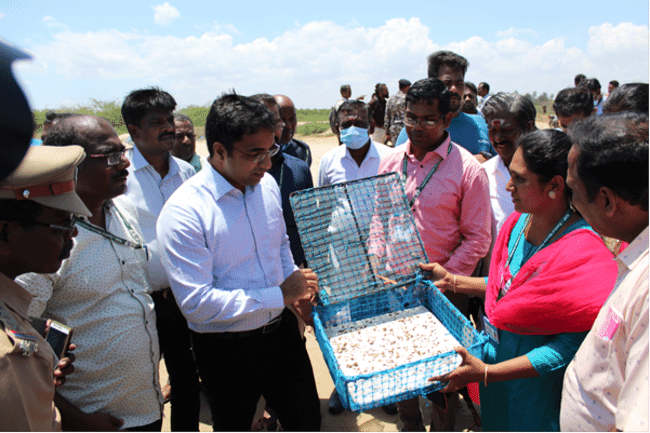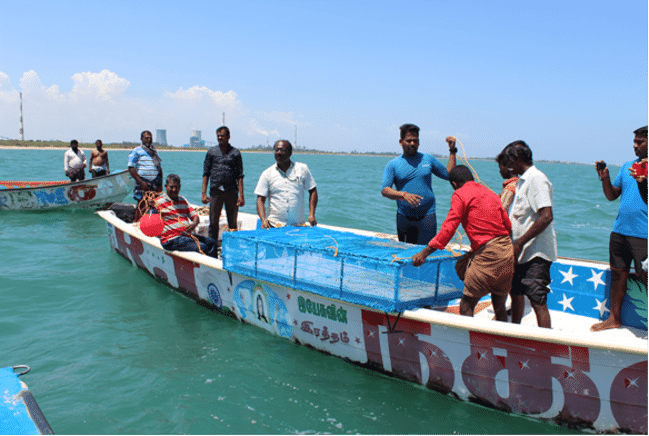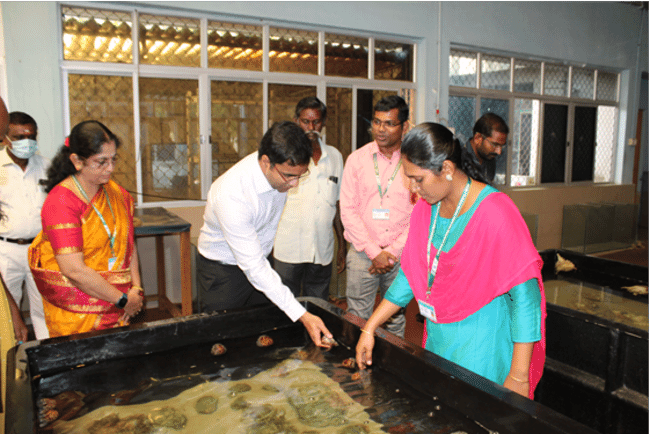
This stock replenishment measure will help restore the depleted pearl oyster population © ICAR-CMFRI
Tuticorin Regional Station of the ICAR-CMFRI produced 5 lakhs of hatchery-produced pearl oyster (Pinctada fucata) spat and released the 5 mm seeds in selected areas of the Gulf of Mannar on 15 September 2022. This stock replenishment measure was initiated by the Shellfish Fisheries Division, ICAR-CMFRI aimed at restoring the depleted population of pearl oysters in the region
District Collector K Senthil Raj inaugurated the sea ranching near “Tharaipaar” close to Tsunami Nagar, Thoothukudi in Tamil Nadu. Appreciating the efforts of ICAR-CMFRI to support the sea-ranching of Indian pearl oysters for stock enhancement, he said that ICAR-CMFRI should continue the initiative until the pearl oyster stock grows to support pearl production. Pearl aquaculture and its associated activities could enhance the livelihood of coastal fishers and provide avenues for social engagement and well-being, especially for fisherwomen. In addition to the main spat release, two cages with different sizes of settled spat were deployed for regular monitoring of sea-ranched pearl oyster spat for its growth at this location.
Tuticorin is popularly known as “Pearl City” as it served as a capital of pearl production and trade centre for centuries until 1961 when the pearl fishery was completely banned by the Department of Fisheries to protect the dwindling pearl oyster stocks. Due to the huge demand for marine pearls, Tuticorin Regional Station of ICAR-CMFRI initiated research work on cultured pearl production and perfected the technology in 1973.

Peals used to be harvested from wild oysters, but after oyster populations began to fall, researchers have been learning how to grow pearls sustainably © ICAR-CMFRI
Local fishers of Thoothukudi district, notably women fishers from Sippikulam village, were trained by ICAR-CMFRI Scientists for the entrepreneurship development in pearl culture technique through funded research programmes. The hatchery produced spat can be raised as an adult and used for pearl culture. ICAR-CMFRI has done commendable work on sea ranching of pearl oyster spat in the paars earlier. However, regular fishing activities in the paar areas kept the population under control without attaining its healthy stock status.
At present, ICAR-CMFRI is planning to rejuvenate the pearl oyster stocks in the pearl oyster paars of Gulf of Mannar through its sea ranching programme. Close monitoring will be carried out to assess its survival and sustainability through dedicated research activities. During the programme, the fishers from the Tsunami colony, who are descendants of pearl fishers and presently engaged in chank fishery, shared their experience of their ancestors and expressed their interest in carrying out pearl culture activity with the support of the Tuticorin Regional Station of ICAR-CMFRI.

ICAR-CMFRI is planning to rejuvenate the pearl oyster stocks in the pearl oyster paars of Gulf of Mannar © ICAR-CMFRI
Dr P S Asha, principal scientist and scientist-in-charge at the Tuticorin Regional Station of CMFRI, Scientist Smt M Kavitha and Scientist Dr C Kalidas also spoke on the occasion. Mr P Vijayaraghavan, assistant director of fisheries, Mrs Vyla, assistant director of fisheries, Mr Sivasubramanian, RDO, Mr Selvakumar, Tehsildar and other officials from the collectorate, scientists and technical staff of the Station and fishers from Tsunami Nagar were present at the function.




